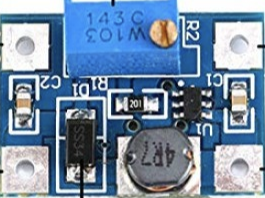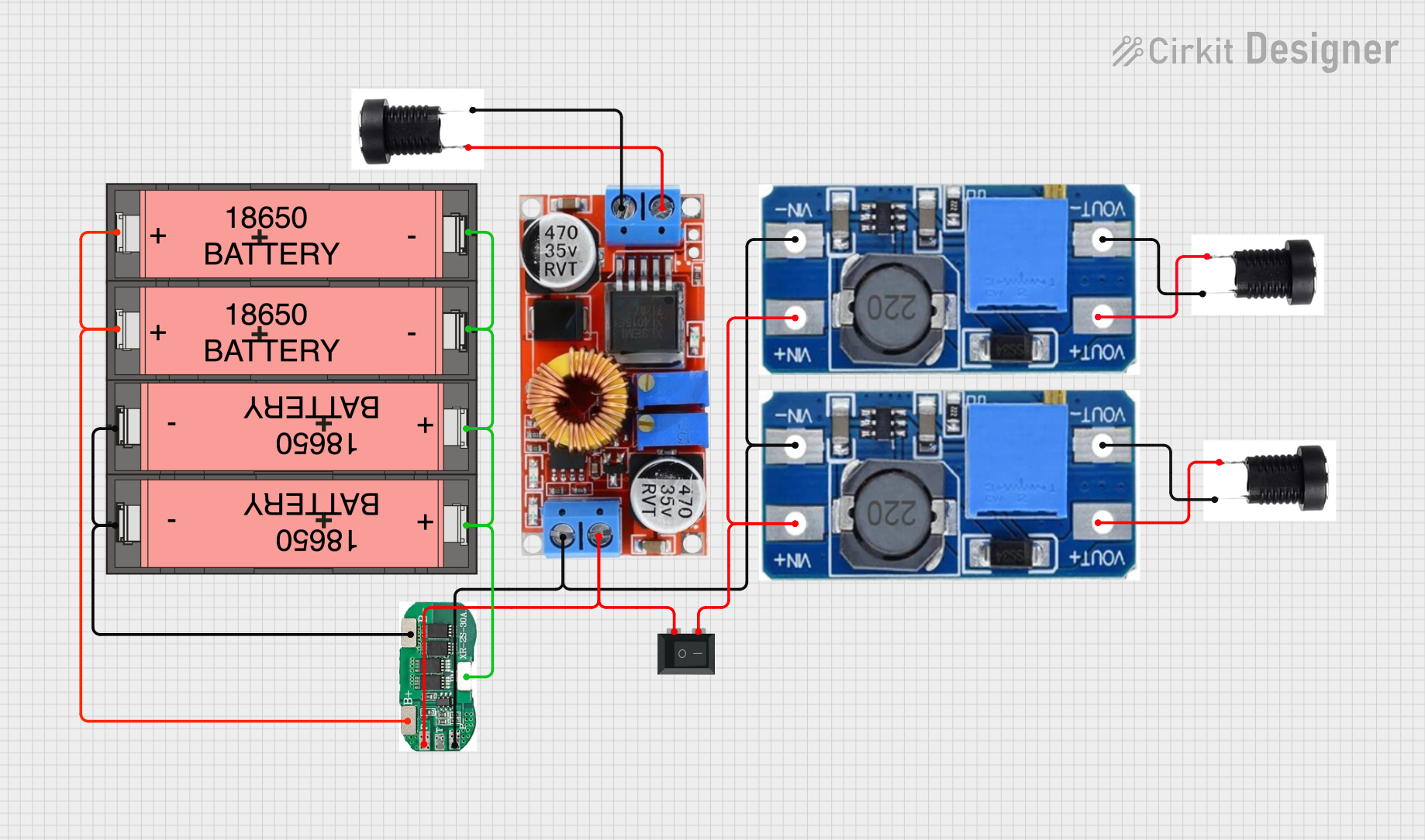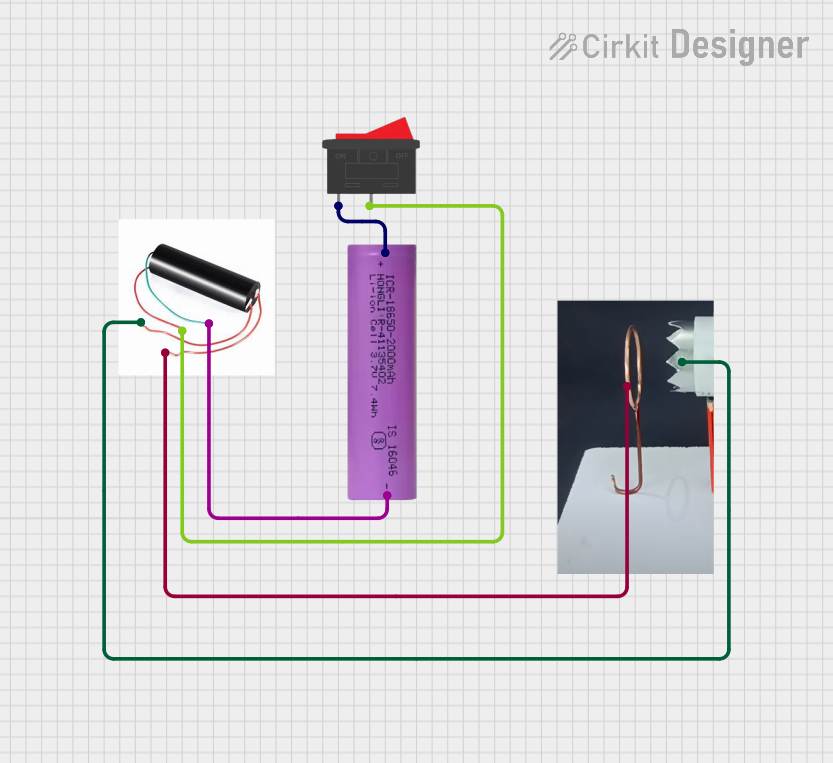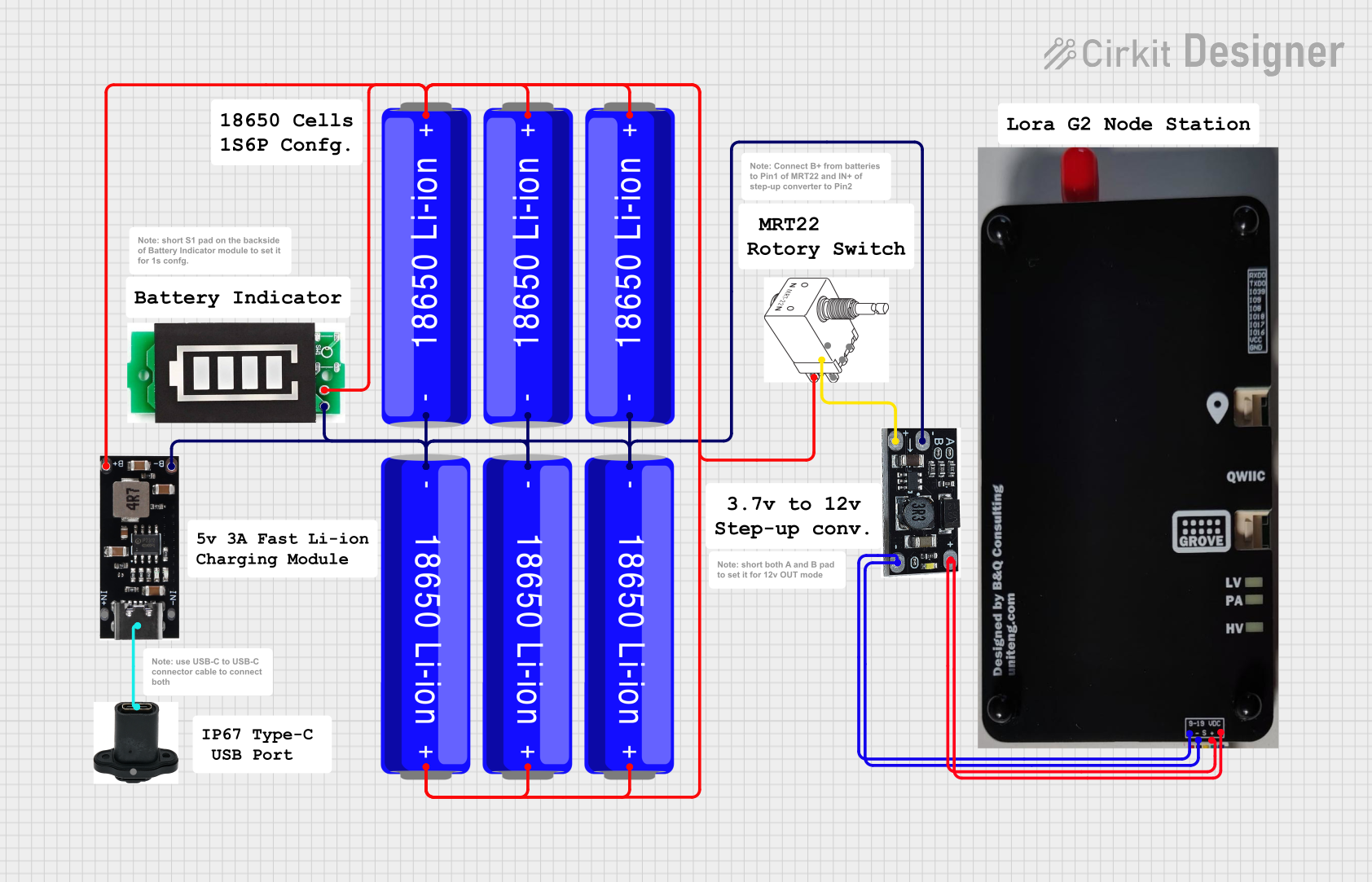
How to Use DC-DC Step Up SX1308 Adjustable Power Supply 28V 2A 1.2Mhz Power Booster Module: Examples, Pinouts, and Specs

 Design with DC-DC Step Up SX1308 Adjustable Power Supply 28V 2A 1.2Mhz Power Booster Module in Cirkit Designer
Design with DC-DC Step Up SX1308 Adjustable Power Supply 28V 2A 1.2Mhz Power Booster Module in Cirkit DesignerIntroduction
The DC-DC Step Up SX1308 Adjustable Power Supply Module is a compact and efficient power booster designed to convert a lower DC voltage to a higher DC voltage. It is capable of outputting up to 28V with a maximum current of 2A, making it suitable for a wide range of applications. The module operates at a high switching frequency of 1.2MHz, ensuring minimal ripple and high efficiency.
Explore Projects Built with DC-DC Step Up SX1308 Adjustable Power Supply 28V 2A 1.2Mhz Power Booster Module

 Open Project in Cirkit Designer
Open Project in Cirkit Designer
 Open Project in Cirkit Designer
Open Project in Cirkit Designer
 Open Project in Cirkit Designer
Open Project in Cirkit Designer
 Open Project in Cirkit Designer
Open Project in Cirkit DesignerExplore Projects Built with DC-DC Step Up SX1308 Adjustable Power Supply 28V 2A 1.2Mhz Power Booster Module

 Open Project in Cirkit Designer
Open Project in Cirkit Designer
 Open Project in Cirkit Designer
Open Project in Cirkit Designer
 Open Project in Cirkit Designer
Open Project in Cirkit Designer
 Open Project in Cirkit Designer
Open Project in Cirkit DesignerCommon Applications and Use Cases
- Powering devices requiring higher voltage from a lower voltage source (e.g., 3.7V to 12V).
- Battery-powered projects, such as lithium-ion or AA battery packs.
- LED strips, displays, and other high-voltage components.
- DIY electronics and prototyping.
- Arduino and microcontroller-based projects requiring adjustable voltage.
Technical Specifications
Below are the key technical details of the SX1308 module:
| Parameter | Value |
|---|---|
| Input Voltage Range | 2V to 24V |
| Output Voltage Range | 2V to 28V (adjustable via potentiometer) |
| Maximum Output Current | 2A |
| Switching Frequency | 1.2MHz |
| Efficiency | Up to 93% |
| Dimensions | 22mm x 17mm x 4mm |
Pin Configuration and Descriptions
The SX1308 module has the following pin layout:
| Pin Name | Description |
|---|---|
| VIN | Input voltage pin. Connect the lower DC voltage source (e.g., battery or power supply). |
| GND | Ground pin. Connect to the ground of the input and output circuits. |
| VOUT | Output voltage pin. Provides the boosted DC voltage. |
Usage Instructions
How to Use the Component in a Circuit
Connect the Input Voltage:
- Connect the positive terminal of your DC power source (e.g., battery) to the
VINpin. - Connect the negative terminal of the power source to the
GNDpin.
- Connect the positive terminal of your DC power source (e.g., battery) to the
Connect the Output Voltage:
- Connect the
VOUTpin to the load (e.g., LED strip, motor, or other devices). - Ensure the load's voltage and current requirements are within the module's output range.
- Connect the
Adjust the Output Voltage:
- Use a small screwdriver to turn the onboard potentiometer clockwise to increase the output voltage or counterclockwise to decrease it.
- Measure the output voltage using a multimeter to ensure it matches your desired value.
Power On:
- Once all connections are secure, power on the input source. The module will boost the input voltage to the desired output level.
Important Considerations and Best Practices
- Input Voltage Range: Ensure the input voltage is within the 2V to 24V range. Exceeding this range may damage the module.
- Output Voltage Limit: Do not exceed the maximum output voltage of 28V or the maximum current of 2A.
- Heat Dissipation: At higher loads, the module may generate heat. Consider adding a heatsink or ensuring proper ventilation.
- Load Compatibility: Verify that the connected load does not draw more current than the module's maximum rating.
- Polarity: Double-check the polarity of the input and output connections to avoid damage.
Example: Using the SX1308 with an Arduino UNO
The SX1308 module can be used to power an Arduino UNO from a lower voltage source, such as a 3.7V lithium-ion battery. Below is an example circuit and code:
Circuit Connections
- Connect the battery's positive terminal to the
VINpin of the SX1308. - Connect the battery's negative terminal to the
GNDpin of the SX1308. - Adjust the output voltage to 5V using the potentiometer.
- Connect the
VOUTpin of the SX1308 to the 5V pin of the Arduino UNO. - Connect the
GNDpin of the SX1308 to the GND pin of the Arduino UNO.
Example Code
// Example code to blink an LED using Arduino UNO powered by the SX1308 module
const int ledPin = 13; // Pin connected to the onboard LED
void setup() {
pinMode(ledPin, OUTPUT); // Set the LED pin as an output
}
void loop() {
digitalWrite(ledPin, HIGH); // Turn the LED on
delay(1000); // Wait for 1 second
digitalWrite(ledPin, LOW); // Turn the LED off
delay(1000); // Wait for 1 second
}
Troubleshooting and FAQs
Common Issues and Solutions
No Output Voltage:
- Cause: Incorrect wiring or loose connections.
- Solution: Double-check all connections, ensuring proper polarity and secure contacts.
Output Voltage Not Adjustable:
- Cause: Faulty potentiometer or incorrect adjustment.
- Solution: Turn the potentiometer slowly and measure the output voltage with a multimeter.
Module Overheating:
- Cause: Excessive load or insufficient ventilation.
- Solution: Reduce the load current or add a heatsink to the module.
Load Not Powering On:
- Cause: Output voltage too low or incompatible load.
- Solution: Verify the load's voltage and current requirements and adjust the output voltage accordingly.
FAQs
Q: Can the SX1308 module step down voltage?
A: No, the SX1308 is a step-up (boost) converter and cannot step down voltage. Use a buck converter for step-down applications.
Q: What is the efficiency of the module?
A: The module has an efficiency of up to 93%, depending on the input voltage, output voltage, and load.
Q: Can I use the SX1308 to power a Raspberry Pi?
A: While the SX1308 can provide 5V output, it may not handle the high current requirements of a Raspberry Pi. Use a module with a higher current rating for such applications.
Q: Is the module protected against reverse polarity?
A: No, the SX1308 does not have reverse polarity protection. Ensure correct polarity to avoid damage.